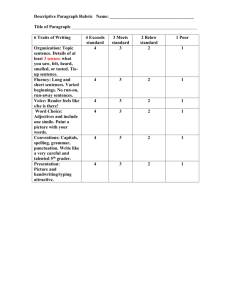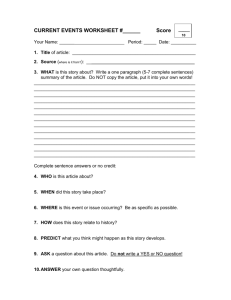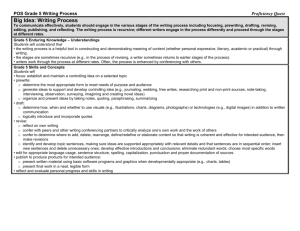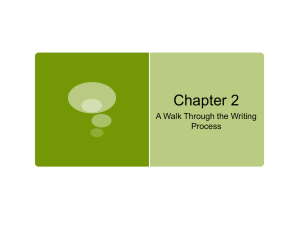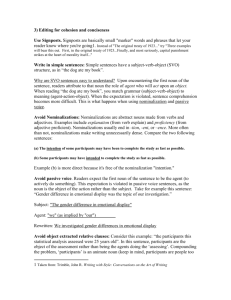Document 10602090
advertisement
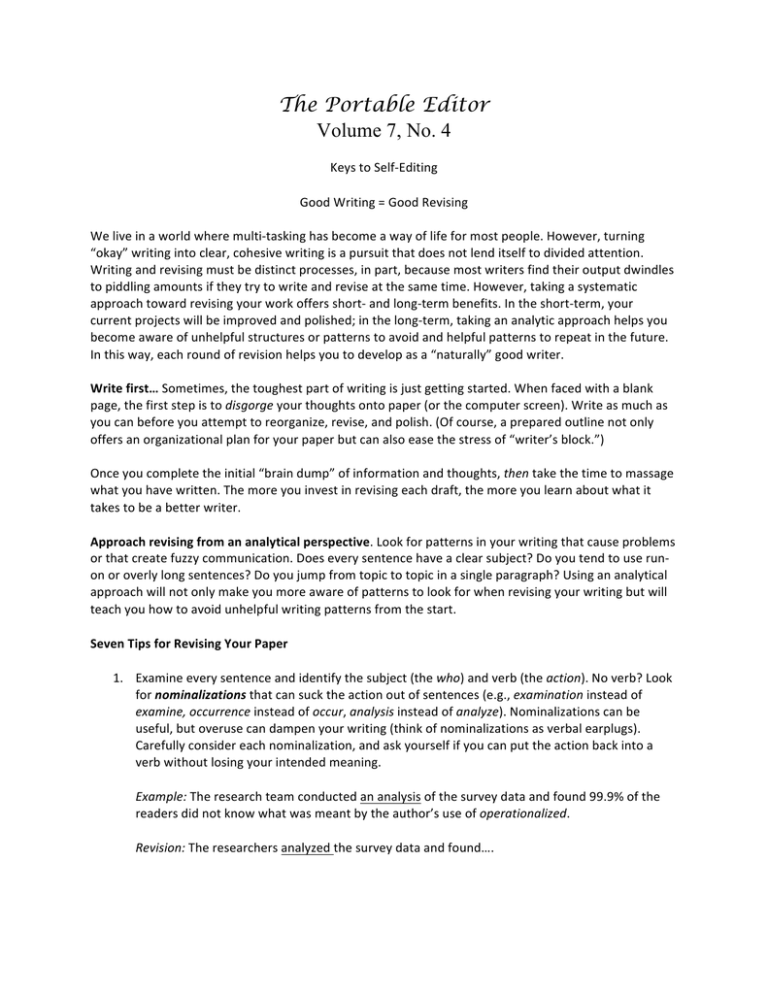
The Portable Editor Volume 7, No. 4 Keys to Self-­‐Editing Good Writing = Good Revising We live in a world where multi-­‐tasking has become a way of life for most people. However, turning “okay” writing into clear, cohesive writing is a pursuit that does not lend itself to divided attention. Writing and revising must be distinct processes, in part, because most writers find their output dwindles to piddling amounts if they try to write and revise at the same time. However, taking a systematic approach toward revising your work offers short-­‐ and long-­‐term benefits. In the short-­‐term, your current projects will be improved and polished; in the long-­‐term, taking an analytic approach helps you become aware of unhelpful structures or patterns to avoid and helpful patterns to repeat in the future. In this way, each round of revision helps you to develop as a “naturally” good writer. Write first… Sometimes, the toughest part of writing is just getting started. When faced with a blank page, the first step is to disgorge your thoughts onto paper (or the computer screen). Write as much as you can before you attempt to reorganize, revise, and polish. (Of course, a prepared outline not only offers an organizational plan for your paper but can also ease the stress of “writer’s block.”) Once you complete the initial “brain dump” of information and thoughts, then take the time to massage what you have written. The more you invest in revising each draft, the more you learn about what it takes to be a better writer. Approach revising from an analytical perspective. Look for patterns in your writing that cause problems or that create fuzzy communication. Does every sentence have a clear subject? Do you tend to use run-­‐ on or overly long sentences? Do you jump from topic to topic in a single paragraph? Using an analytical approach will not only make you more aware of patterns to look for when revising your writing but will teach you how to avoid unhelpful writing patterns from the start. Seven Tips for Revising Your Paper 1. Examine every sentence and identify the subject (the who) and verb (the action). No verb? Look for nominalizations that can suck the action out of sentences (e.g., examination instead of examine, occurrence instead of occur, analysis instead of analyze). Nominalizations can be useful, but overuse can dampen your writing (think of nominalizations as verbal earplugs). Carefully consider each nominalization, and ask yourself if you can put the action back into a verb without losing your intended meaning. Example: The research team conducted an analysis of the survey data and found 99.9% of the readers did not know what was meant by the author’s use of operationalized. Revision: The researchers analyzed the survey data and found…. 2. Does each sentence make a point? Ask yourself, “What is this sentence about?" Does the sentence have a clear subject? If a sentence isn’t making a point, it might be a phrase masquerading as a sentence; in this case, revise the non-­‐sentence by making it a clause in another sentence. Example. Dworsky et al. (2014) agreed the recent policy changes had important implications. Revision. Recent policy changes have important implications for social workers involved in direct practice with Medicare clients; these implications have been explained by leaders in the aging field such as Dworsky et al.’s (2014) study of the “donut hole” gap. 3. Look for links between one sentence and the next. In his book, The Sense of Structure: Writing from the Reader's Perspective, George Gopen teaches writers to create cohesive paragraphs by putting information that is familiar to the reader at the beginning of a sentence and placing new information at the end of the sentence. This pattern of familiar — new —familiar—new creates a flow of thoughts and information that most readers can easily follow. Examine your paragraphs for this type of backward linking structure (i.e., the part of the sentence that links to the previous sentence). Is the backward link at the beginning or the end of the sentence? If at the end, try Gopen’s technique and reverse the positioning of familiar information. Apply this principle in moderation; not every sentence will have a backward link, and too much of a good thing can be a bad thing! Example: The research team analyzed the survey data and found 99.9% of the readers did not know what was meant by the author’s use of operationalized. Their analysis also revealed a majority of readers chose to rely on context to discern the meaning of unfamiliar words. The use of obscure terms and jargon not only creates barriers to communication but also irritates readers. Yikes! Doesn’t the second sentence in this example contradict the tip about avoiding nominalizations? Remember, nominalizations are not inherently evil, and nominalizations work well to create a backward link. 4. Analyze each paragraph by summarizing its main point. Do you switch topics in a paragraph? Is this an intentional stringing of topics or an indication of flawed organization? You can determine whether you need to create separate paragraphs by making sure each sentence supports the main topic; if not, you probably need a new paragraph. Do the first and last sentences of the paragraph address the same topic? (Hint: The topic (not the language) of the first and last sentences should match). 5. Read your paper aloud or save it as a PDF and use the text-­‐to-­‐voice option to read your paper. (Warning: The Adobe read-­‐aloud option can’t handle words such as biopsychosocial, but the efforts can be quite entertaining!). Listen for sentences that are repetitive, unclear, too long (Hint: if you need to take a breath while reading a sentence, it’s too long!), too short, awkwardly phrased, or off-­‐topic. 6. Do a text search for the following problematic writing habits: • unnecessary filler words or intensifiers (e.g., very, really, actually, extremely); • • • • • expletive constructions (e.g., there are, there is); inflated words (e.g., utilize instead of use; facilitate instead of help; cognizant instead of aware or known; subsequent to instead of after; employ instead of use); pronouns that are not clearly anchored to a referent (e.g., This means, they, these, them, it); long noun strings (agency employee relations improvement program instead of a program to improve relations among employees); and words or phrases that add little meaning (e.g., in order to, it should be noted, the fact of the matter is; concerning the matter of…; in a situation in which this occurs [this last phrase can replaced with when]). Example: There are likely to be many researchers who will raise questions related to the decision of the research team to utilize this methodological approach. Revision: Some researchers might question the research team’s chosen approach. 7. After completing all of your rounds of revisions, it’s still a wise idea to ask a friend or colleague to read your paper to evaluate the writing for clarity and flow (and the strength of your argument if the person is knowledgeable about your topic). Above all, remember these tips are based on principles of good writing and should not be considered as hard-­‐and-­‐fast rules. Thus, the last tip comes from George Orwell’s 6 Questions/ 6 Rules for writers: “6. Break any of these rules sooner than say anything outright barbarous.” Need One-­‐on-­‐One Writing Support? Please email to schedule an appointment: soswwritingsupport@gmail.com


